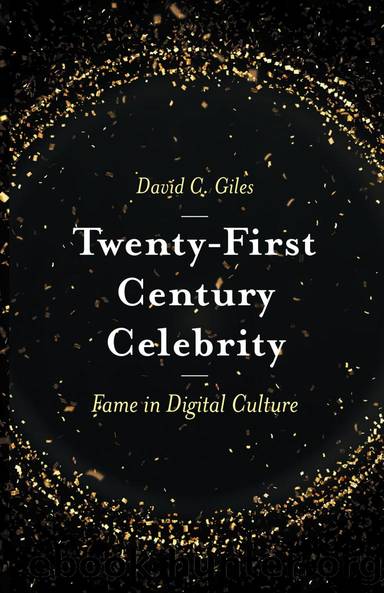Twenty-First Century Celebrity by David C. Giles

Author:David C. Giles [Giles, David C.]
Language: eng
Format: epub
Barnesnoble:
Publisher: Emerald Publishing
Published: 2018-09-13T00:00:00+00:00
The Challenge Format
A popular format among YouTubers of all stripes is the challenge, which has spawned several sub-formats of its own (the ice bucket challenge, condom challenge and so on), and gives them the opportunity to maximise their potential audience by enlisting the participation of fellow YouTubers. This is usually traditional slapstick entertainment that is particularly enjoyed by younger fans (Andò, 2016).
YouTubers as (Micro?)-celebrities
Having described the broad cultural environment of YouTube and its opportunities for new kinds of highly popular individual to emerge, I would now like to turn to the question of whether we can consider these individual celebrities in the traditional sense of the word (that is, in accordance with the definitions outlined in chapter 1) or whether they are better understood as an entirely new phenomenon. Is the concept of micro-celebrity sufficient to describe the likes of PewDiePie and Zoella with their vast global audiences, or do we need a unique concept to capture these emerging public figures?
The first issue to resolve is how we might best distinguish YouTube celebrities from other forms of celebrity, traditional and digital. A simple, but useful, definition is provided by Lovelock (2017, p. 90): âYouTube celebrity denotes an individual whose celebrity stems directly from their activities on the site.â I would amend this slightly, replacing âcelebrityâ with âfameâ because, though celebrity status may be somewhat in dispute (and some definitions of celebrity are based on representation in traditional media), there can be little disagreement with the claim that someone with 62 million subscribers is famous.
One interesting phenomenon to be considered is that YouTubers themselves, and particularly their fans, are not always comfortable with the term âcelebrityâ. In a television interview with Sky News, Alfie Deyes claimed that his success was down to not being a celebrity: âI think what people love about vlogging is that we arenât celebrities, weâre just normal⦠itâs the normality that people loveâ (Nkadi, 2015). It is a sentiment echoed by (some of) his fans: âHeâs normal, not like celebritiesâ, said one teenage girl at a Deyes book signing (Samadder, 2014) although another interviewee disputed this. The attractiveness of ânormalityâ has clear links with that of âordinarinessâ, and inevitably, authenticity, which is explored in more depth in the next chapter.
A rare academic study that has collected interview data with vloggers and their adolescent audience is Andò (2016), in which the latter group was particularly dismissive of the term. Vloggers, according to one fan (Ibid, p. 133), âare not real celebrities⦠just simple girls who tell us about their lives. They donât want to be stars.â Most fans stressed how similar the vloggers were to themselves (âthey talk about their everyday life, their school and so onâ and âthe same things happen to meâ); the age gap, rather than a distancing factor, was seen as a reason to trust their advice. Rather than explicitly rejecting the celebrity label, the vloggers themselves tended towards modesty, describing it instead as âthis completely absurd experience on YouTubeâ, as a temporary status that is âreally niceâ, âbeautifulâ, and so on.
Download
This site does not store any files on its server. We only index and link to content provided by other sites. Please contact the content providers to delete copyright contents if any and email us, we'll remove relevant links or contents immediately.
Cecilia; Or, Memoirs of an Heiress — Volume 1 by Fanny Burney(32495)
Cecilia; Or, Memoirs of an Heiress — Volume 2 by Fanny Burney(31909)
Cecilia; Or, Memoirs of an Heiress — Volume 3 by Fanny Burney(31889)
The Great Music City by Andrea Baker(31756)
We're Going to Need More Wine by Gabrielle Union(19003)
All the Missing Girls by Megan Miranda(15773)
Pimp by Iceberg Slim(14433)
Bombshells: Glamour Girls of a Lifetime by Sullivan Steve(14020)
For the Love of Europe by Rick Steves(13558)
Talking to Strangers by Malcolm Gladwell(13290)
Norse Mythology by Gaiman Neil(13278)
Fifty Shades Freed by E L James(13186)
Mindhunter: Inside the FBI's Elite Serial Crime Unit by John E. Douglas & Mark Olshaker(9260)
Crazy Rich Asians by Kevin Kwan(9220)
The Lost Art of Listening by Michael P. Nichols(7453)
Enlightenment Now: The Case for Reason, Science, Humanism, and Progress by Steven Pinker(7272)
The Four Agreements by Don Miguel Ruiz(6698)
Bad Blood by John Carreyrou(6581)
Weapons of Math Destruction by Cathy O'Neil(6214)
